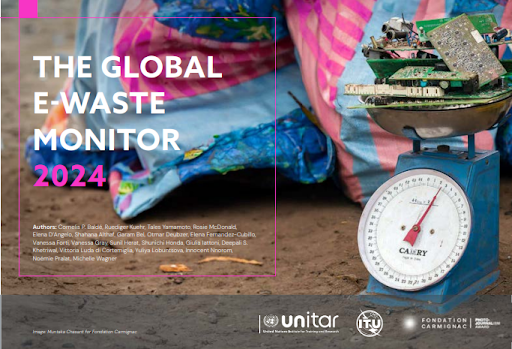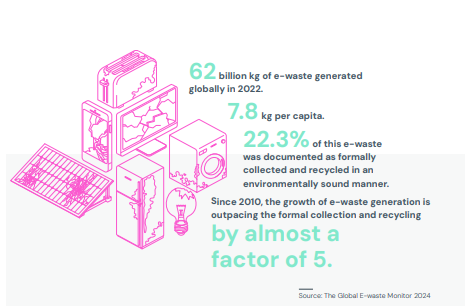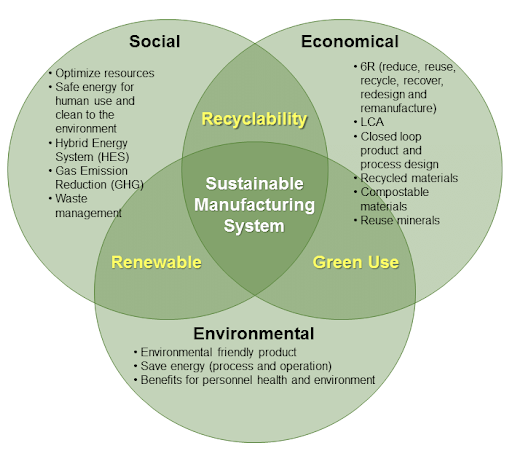
Image Source: Global E-Waste Monitor 2024
The ever-growing mountain of discarded electronics, known as e-waste, presents a formidable challenge to our planet’s health. In 2019 alone, the world generated a staggering 53.6 million metric tons of e-waste, enough to fill 4,500 Olympic-sized swimming pools. This alarming trend underscores the urgent need for sustainable solutions. While consumers play a role in responsible disposal, manufacturers hold a pivotal position in addressing the e-waste crisis by adopting sustainable product design and responsible manufacturing practices.
Why the E-Waste Crisis Needs Affirmative Action
 Each year, the world generates over 50 million metric tons of e-waste – a figure that’s projected to double by 2050 if left unchecked. This discarded electronic equipment, laden with hazardous materials like lead, mercury, and cadmium, poses a grave threat to our ecosystems and public health. While consumers certainly have a role to play in responsible e-waste disposal, manufacturers are equally, if not more, responsible for addressing this crisis.
Each year, the world generates over 50 million metric tons of e-waste – a figure that’s projected to double by 2050 if left unchecked. This discarded electronic equipment, laden with hazardous materials like lead, mercury, and cadmium, poses a grave threat to our ecosystems and public health. While consumers certainly have a role to play in responsible e-waste disposal, manufacturers are equally, if not more, responsible for addressing this crisis.
It’s not just about complying with regulations; it’s about embracing sustainable product design and responsible manufacturing practices that prioritise longevity, repairability, and recyclability. It’s about creating a circular economy where electronic devices have a longer lifespan and minimal environmental impact.
Image Source: Global E-Waste Monitor 2024
The Power of Sustainable Design and Manufacturing

Source: Research Gate
The journey of an electronic device begins long before it reaches the consumer’s hands. From the drawing board to the assembly line, manufacturers have the power to influence a product’s environmental impact. By embracing sustainable design and manufacturing principles, they can drastically reduce e-waste and contribute to a circular economy.
Product Design for Durability: Built to Last
One of the most effective ways to combat e-waste is to design products that are built to last. By prioritising durability and longevity, manufacturers can extend the lifespan of electronic devices, reducing the frequency of replacements and the amount of e-waste generated.
Several design characteristics can improve product durability.
- Modular Design: Enables easy repair and replacement of individual components, increasing the product’s life.
- Robust Materials: Using high-quality, robust materials assures that the product will survive wear and tear.
- Software upgrades: Providing frequent software upgrades can help older devices remain functional and relevant for longer.
There are numerous advantages to designing long-lasting products.
- Reduced E-Waste: Fewer devices discarded prematurely results in less e-waste in landfills.
- Resource Conservation: Longer product lifespans reduce the need for fresh raw materials, lowering the environmental effect of extraction and manufacturing.
- Consumer Cost Savings: Investing in durable items can save consumers money in the long run by reducing the frequency with which they must replace their equipment.
Examples of durable design features include:
- Standardised components for easier replacement
- User-replaceable batteries
- Software updates to extend product lifespan
- Clear repair manuals and accessible spare parts
- By prioritising durability, manufacturers can extend the lifespan of electronic products, reduce the frequency of replacements, and ultimately decrease the amount of e-waste generated.
Using Sustainable Materials in Manufacturing Processes: Greener Options

Image Source: MDPI – Ellen MacArthur Foundation. Towards a Circular Economy: Business Rationale for an Accelerated Transition. 2013.
The materials used in electronics manufacture have a significant environmental impact. Traditional materials, such as plastics and certain metals, are difficult to recycle and may contain harmful compounds. Manufacturers may reduce their goods’ environmental impact and improve e-waste recycling by using sustainable and recyclable materials.
Sustainable Materials Gaining Traction in Electronics
- Bioplastics: Derived from renewable sources like corn or sugarcane, bioplastics offer a greener alternative to traditional petroleum-based plastics.
- Recycled Metals: Reusing metals reduces the need for new mining operations, thus conserving valuable resources.
- Conflict-Free Minerals: Ensuring minerals are sourced ethically and responsibly helps to prevent human rights abuses.
The use of sustainable materials benefits both the environment and enterprises.
- Reduced Environmental Impact: Eco-friendly materials are less hazardous to the environment during manufacturing, usage, and disposal.
- Improved Brand Image: As consumers become more aware of the importance of sustainability, organisations that use environmentally friendly products can improve their brand reputation.
Successful examples of such initiatives include:
Apple’s Renew program, which offers free recycling or trade-in for eligible devices.
Dell’s Reconnect program, which partners with Goodwill to provide convenient e-waste drop-off locations.
HP’s Planet Partners program, which offers a range of recycling and take-back options for consumers and businesses.
Extended Producer Responsibility and Circular Economy Practices: Rethinking the Linear Model
Extended Producer Responsibility (EPR) is a strategy that takes producers’ obligation beyond the moment of sale, holding them accountable for the environmental impact of their products throughout their full lifecycle, from disposal to recycling. By including the financial cost of end-of-life management in their operations, EPR motivates manufacturers to prioritise sustainable product design and actively contribute to the development of recycling infrastructure.
The circular economy takes this concept further, aiming to eliminate waste and keep resources in use for as long as possible. Manufacturers can embrace circular economy practices by:
- Designing for Disassembly and Recycling: Creating products that are easy to take apart and recycle at the end of their life.
- Offering Repair and Upgrade Services: Extending the lifespan of products through repair and upgrade options.
- Using Recycled Materials: Incorporating recycled materials into new products, reducing the need for virgin resources.
Key Roles of Manufacturers in the E-Waste (Management) Amendment Rules, 2024
- Increased Extended Producer Responsibility (EPR).
- Increased collection targets: Manufacturers now have a larger obligation to collect and recycle e-waste generated by their products. This pushes them to create items that are easier to recycle and to set up effective collection and recycling systems.
- EPR Certificate Exchange Platform
- Flexibility and Efficiency: The government’s potential establishment of a platform for exchanging or transferring EPR certificates provides manufacturers with more flexibility in meeting their EPR obligations.
- Market-Driven Solutions: This could lead to a more market-driven approach to e-waste management practices, where manufacturers can buy or sell certificates based on their recycling performance.
- Relaxation of Reporting Deadlines (Conditional)
- Flexibility in Compliance: The government has the authority to extend reporting deadlines under specific circumstances, offering some relief to manufacturers facing challenges in meeting their EPR targets. However, this is conditional and subject to the government’s discretion.
- Dismantler’s Role Clarified
- Clearer Definition: The amendment provides a clearer definition of “dismantler” as an entity involved in dismantling used electrical and electronic equipment according to CPCB guidelines.
- Emphasis on Traceability: This reinforces the importance of proper material flow and record-keeping within the recycling process, ensuring accountability and traceability of e-waste.
Overall, the E-Waste (Management) Amendment Rules, 2024, place a greater emphasis on manufacturer accountability and encourage environmentally friendly practices. Manufacturers may help reduce e-waste and promote a circular economy by understanding and following these requirements.
The e-waste situation requires prompt solutions, and manufacturers play a critical role. They may significantly minimise the quantity of e-waste generated and its environmental impact by focussing on sustainable product design, ethical manufacturing practices, and circular economy principles.
Namo eWaste: Your Trusted Partner in ITAD & EPR Solutions
Namo eWaste collaborates closely with manufacturers and customers to encourage responsible e-waste management. We recognise the complexities of e-waste management and the unique issues that businesses face. Our broad portfolio of services is intended to ease the process while guaranteeing regulatory compliance and promoting environmental responsibility.
IT Asset Disposition (ITAD)
We provide secure and responsible IT asset disposition services such as data destruction, equipment refurbishing, and remarketing. Our cutting-edge facilities and approved certified processes ensure the safe and compliant handling of your sensitive data and equipment, reducing environmental impact and increasing asset recovery value.
Extended Producer Responsibility (EPR) & Reverse Logistics:
We provide comprehensive, professional e-waste management services to help manufacturers satisfy their EPR and reverse logistics obligations. We help you manage the complete lifecycle of electronic items, from collection and transportation to recycling and disposal, assuring responsible practices and compliance with regulations.
Contact us today for a free consultation and discover how we can help your business achieve its sustainability goals along with government standards. Don’t let e-waste weigh down your business or your conscience.
Alternatively, you can give us a call at 1800-123-5124 or email your organisation’s ITAD & EPR concerns at info@namoewaste.com.


